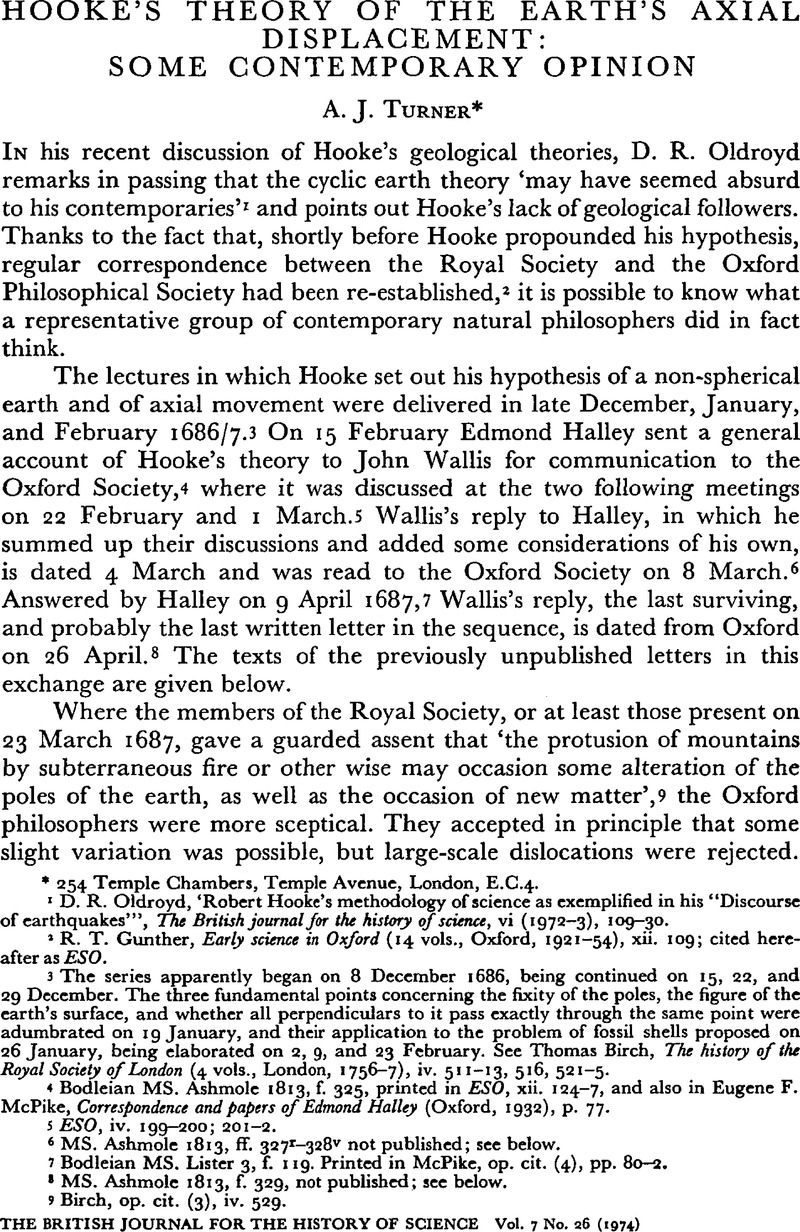Article contents
Hooke's Theory of the Earth's Axial Displacement: Some Contemporary Opinion
Published online by Cambridge University Press: 05 January 2009
Abstract

- Type
- Notes
- Information
- Copyright
- Copyright © British Society for the History of Science 1974
References
1 Oldroyd, D. R., ‘Robert Hooke's methodology of science as exemplified in his “Discourse of earthquakes”’, The British journal for the history of science, vi (1972–1973), 109–30.CrossRefGoogle Scholar
2 Gunther, R. T., Early science in Oxford (14 vols., Oxford, 1921–1954), xii. 109Google Scholar; cited hereafter as ESO.
3 The series apparently began on 8 December 1686, being continued on 15, 22, and 29 December. The three fundamental points concerning the fixity of the poles, the figure of the earth's surface, and whether all perpendiculars to it pass exactly through the same point were adumbrated on 19 January, and their application to the problem of fossil shells proposed on 26 January, being elaborated on 2, 9, and 23 February. See Birch, Thomas, The history of the Royal Society of London (4 vols., London, 1756–1757), iv. 511–13, 516, 521–5.Google Scholar
4 Bodleian MS. Ashmole, 1813, f. 325Google Scholar, printed in ESO, xii. 124–7Google Scholar, and also in McPike, Eugene F., Correspondence and papers of Edmond Halley (Oxford, 1932), p. 77.Google Scholar
5 ESO, iv. 199–200Google Scholar; 201–2.
6 MS. Ashmole, 1813, ff. 327r–328vGoogle Scholar not published; see below.
7 Bodleian MS. Lister, 3, f. 119Google Scholar. Printed in McPike, , op. cit. (4), pp. 80–2.Google Scholar
8 MS. Ashmole, 1813, f. 329Google Scholar, not published; see below.
9 Birch, , op. cit. (3), iv. 529.Google Scholar
10 Printed by permission from Bodleian Library MS. Ashmole, 1813, ff. 327v–328v.Google Scholar
11 This qualification, which is written above the line in the MS., was clearly an afterthought on Wallis's part.
12 Viri illustris Nicolai Claudii Fabricii de Peiresc, … Vita per Petrum Gassendum (Paris, 1641), pp. 316–18Google Scholar. The mirrour of true nobility and gentility being the life of … Nicolaus … Peiresc … written by … Petrus Gassendus … englished by W. Rand (London, 1657), pp. 142–6.Google Scholar
13 Riccioli, G. B., Almagestum novam astronomiam veterem novamque complectens … in tres tomos distributum (Bologna, 1651), p. 16Google Scholar. The question is discussed in more detail in Geographiae et hydrographiae reformatae libri dvodecim (Bologna, 1661), 300–20Google Scholar. Pythias's observations and Gassendi's reference are discussed on p. 320, col. 1.
14 Pierce, Robert (?1622–1710)Google Scholar, a noted physician practicing in Bath, , presented this shell on 6 10 1685 (ESO, iv. 161Google Scholar), although it had been reported and discussed in November 1684. For a description of the finding of the shell, see Pierce's letter to Aubrey, John, 28 11 1684, in ESO, xii. 237.Google Scholar
15 Printed by permission from MS. Ashmole, 1813, f. 329r.Google Scholar
- 9
- Cited by


